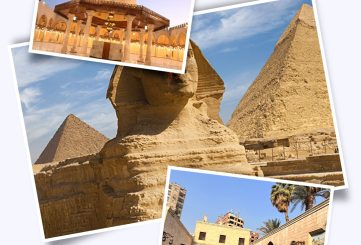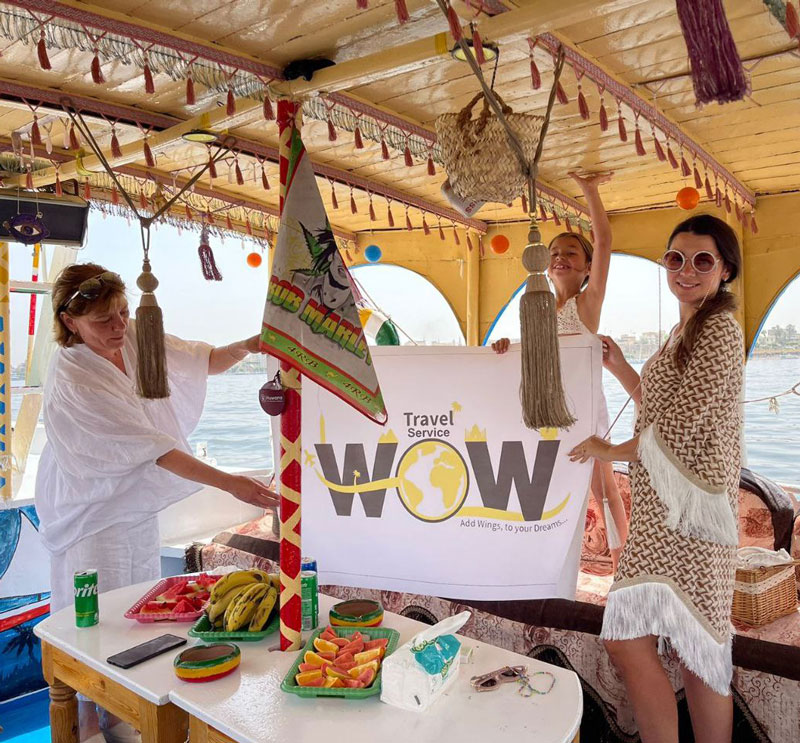Luxor for 2 days from Hurghada
- 2 people (car): $350, $175 per person
- 3 people (car): $495, $165 per person
- 4 people (car): $580, $145 per person
- 5 - 8 people (minibus): $130 per person
- For more than 8 people, price upon request
Day 1:
- Transfer from the hotel around 4:00 am, depending on the hotel's location.
- City of the Living: Visit the Karnak Temple Complex (scarab beetle statue, sacred lake).
- Boat trip to the other bank of the Nile.
- Lunch at a restaurant with a view of the river (buffet style).
- City of the Dead: Colossi of Memnon, visit the Temple of Queen Hatshepsut.
- Optional boat trip to Banana Island (booked through the guide).
- Transfer to the hotel in Luxor.
Day 2:
- Optional hot air balloon flight at sunrise (booked through the guide).
- City of the Living: Visit the Luxor Temple, walk along the Sphinx Avenue.
- Boat trip to the other bank of the Nile.
- Lunch at a restaurant with a view of the river (buffet style).
- City of the Dead: Valley of the Kings, visit the Temple of Ramesses III at Medinet Habu.
- Boat trip to Banana Island.
- Stone Products Factory / Perfume Factory.
- Transfer to Hurghada, arrival at the hotel around 10:00 pm, depending on the hotel's location.
*The itinerary may vary depending on the flow of tourists.
- Passport.
- Water, hotel dry rations or snacks.
- Headgear.
- Sunglasses.
- Sunscreen.
- Comfortable footwear.
- Warm clothing during winter months.
- Money for personal expenses.
- Advance payment of $50 per person, refundable if the tour is canceled at least one day in advance.
- Children aged 6 and above are allowed for the hot air balloon flight.
Included:
- Transportation service.
- Individual transfer in an air-conditioned car or minibus.
- 1 night in a 3-star hotel with breakfast included.
- Guide - egyptologist.
- Entrance tickets to all mentioned attractions.
- 2 lunches at restaurants.
Not included:
- Additional expenses not included in the program.
- Drinks at the restaurant and hotel.
- Entrance tickets to the tomb of Tutankhamun.
- Boat trip to Banana Island on the first day - $10.
- Hot air balloon flight - $50.
- Transportation service within Hurghada round trip for up to 6 people:
Hotels in El-Gouna, Sahel-Hashish - $10
Hotels in Soma Bay (Kempinski and Sheraton) - $15
Luxor is rightly considered the largest open-air museum, and its name comes from the Arabic “Al-Uqsur,” which means “palaces.” The Nile River divides the city into two parts: the right (eastern) bank, known as the “City of the Living,” and the left (western) bank, known as the “City of the Dead.”
The Karnak Temple Complex covers an area of 1.5 km by 700 m. Construction of the complex began in the 20th century BCE and lasted for 13 centuries. Karnak is the only temple consisting of 10 halls and 10 pylons (gates). Highlights of the excursions usually include the statue of the scarab beetle, which is believed to grant wishes, and the sacred lake measuring 129 x 77 m, which was used for ritual purification. A sacred pathway, represented by an avenue of sphinxes, connects the Karnak Temple Complex to the Luxor Temple.
The Colossi of Memnon are the only remaining reminders of the temple of Amenhotep III, built around 1400 BCE. The temple was completely destroyed by an earthquake around 1200 BCE, but the colossi have survived. Another strong earthquake in the 27th century BCE partially destroyed the left statue, and the colossus began “singing” at dawn. However, after the restoration of the colossus in 199 CE, the singing ceased.
The Temple of Queen Hatshepsut was built between 1482 and 1473 BCE. Its ancient name, Djeser-Djeseru, translates to “the Holy of Holies.” The temple of the female pharaoh was a place of pilgrimage, where people left requests for assistance or healing from diseases on the walls.
The Luxor Temple was built between 1388 and 1351 BCE. The temple is dedicated to the sun god Amun-Ra, his wife, and son. Throughout ancient Egyptian history, rulers repeatedly expanded and renovated the Luxor Temple Complex.
The Valley of the Kings was the burial site from the 16th to the 11th century BCE. Currently, over 50 tombs of pharaohs have been excavated, but archaeological excavations are still ongoing. The most famous tomb, discovered in 1922, is that of Tutankhamun, which gave rise to the legend of the “Curse of the Pharaohs.”
The construction of the Temple of Ramesses III at Medinet Habu began with Ramesses III’s ascension to the throne and was completed in 1156 BCE. Inside the temple, the reliefs depict the pharaoh’s military victories, and the fortified temple complex served as a refuge for the local population during invasions of Egypt.
During a visit to Banana Island, you can see not only how bananas grow but also other fruits such as mangoes and mandarins, as well as sugar cane, mint, and various spices. There is a café on the island where freshly harvested bananas are offered for free, and you can also pick them directly from the “banana tree” (bush) during a walk on the island.
The Stone Products Factory (Alabaster Factory) partly resembles a museum. During the visit, you will learn about the technology of alabaster production and how to distinguish genuine alabaster products from imitations. If desired, you can purchase souvenirs made of genuine stone.
During a visit to the Perfume Factory, the guide will explain the techniques of oil and perfume production. The factory’s shop offers high-quality oils and oil-based perfumes for sale.









